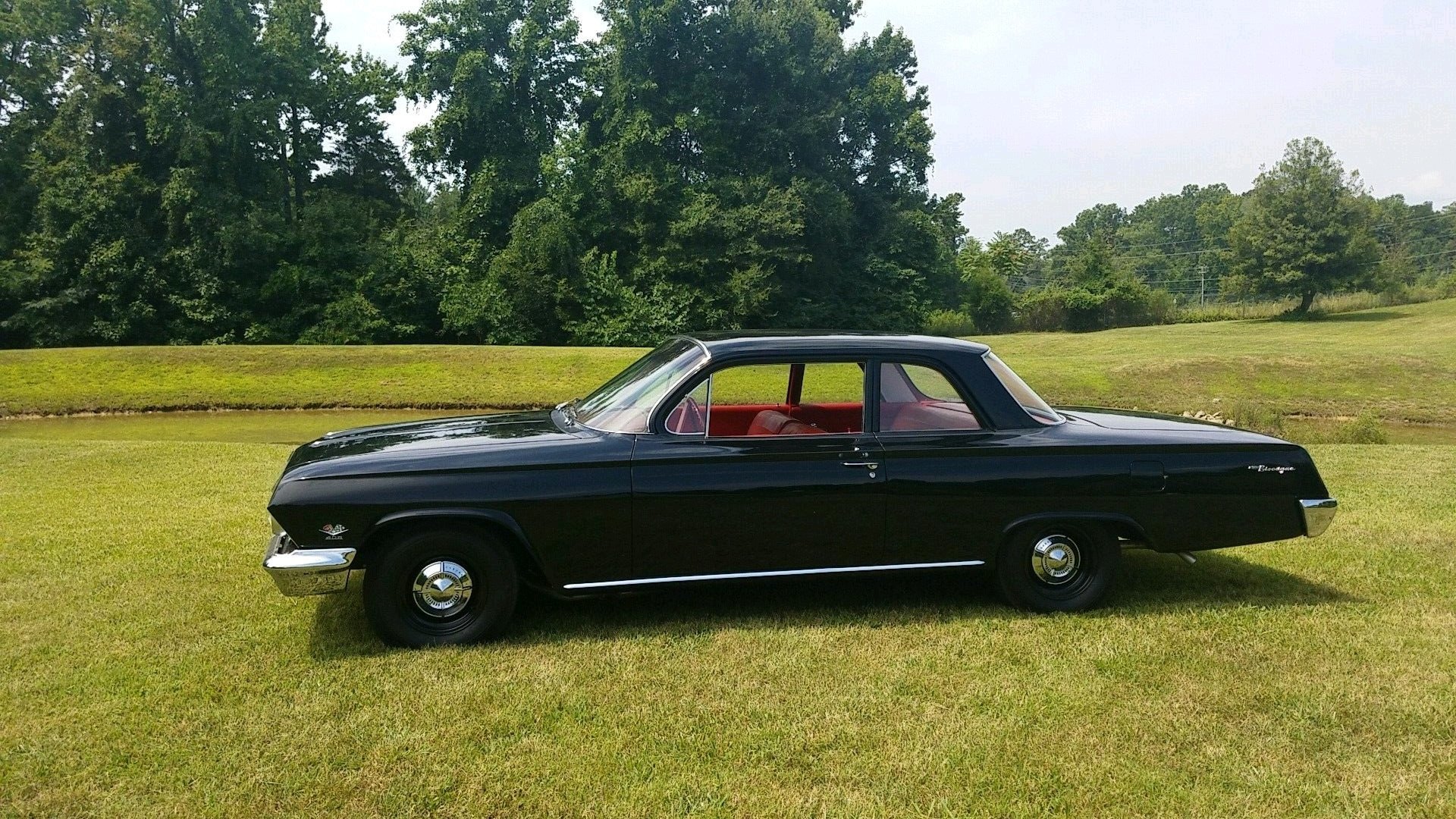Lot # FR0268
Vehicle Highlights
- Frame Off Restoration
- 409/409 HP Engine
- Dual 4-Barrel Carburetors
- 4-Speed Manual Transmission
- Black Exterior
- Red Plaid Seats
- Radio, Heater, Clock and Lighter Delete
- Column Mounted Sun Tachometer
- NOS Dog Dish Hubcaps
- Refinished Chrome, Paint and Interior
- 150 Miles Since Restoration





409 CID / 409 HP / 4-Speed Manual
This 1962 Chevrolet Biscayne has undergone a recent frame-off restoration and is a 1960s-era drag-racing icon: it has the dual-quad 409 CI engine, a 4-speed transmission, the post-coupe body style, radio delete, heater delete, clock delete, lighter delete, vinyl floor mat and a column-mounted Sun Tachometer. The 1960s are considered by many as the golden era of NHRA Super Stock racing where factory full-size production cars manufactured by the Big Three (General Motors, Ford and Chrysler) competed head to head on the drag strips of America. The Chevrolet 409 was the scourge of the 1962 season with legendary drivers such as Dave Strickler, Hayden Proffitt and “Dyno Don” Nicholson competing in the hotly contested Super Stock class with quarter-mile elapsed times in the 12-second range and terminal speeds approaching 120 MPH. This street-legal Chevrolet 409 Biscayne represents the foundation of these legendary race cars. The 409 CI engine was introduced at the tail end of 1961. It was a 1962 factory option across the entire full-size model lineup (Biscayne, Bel-Air and Impala) and was offered in two versions: 380 HP and 409 HP. Both came equipped with solid lifters, dual exhaust and 11.0:1 compression ratio. What differentiated the two was the dual 4-barrel carburation set up on the 409 HP version, as opposed to a single 4-barrel on the 380 HP version. This car is a post-coupe Biscayne—highly coveted by the drag racers for both its light weight (approximately 100-pounds less than the hardtop Impalas and Bel-Airs) and its inherent structural integrity.
1962 Chevrolet
Biscayne 409
- Year
- 1962
- Make
- Chevrolet
- Model
- Biscayne
- Body Color
- Black
- Interior Color
- Red
409 CID / 409 HP / 4-Speed Manual
Vehicle Highlights
- Frame Off Restoration
- 409/409 HP Engine
- Dual 4-Barrel Carburetors
- 4-Speed Manual Transmission
- Black Exterior
- Red Plaid Seats
- Radio, Heater, Clock and Lighter Delete
- Column Mounted Sun Tachometer
- NOS Dog Dish Hubcaps
- Refinished Chrome, Paint and Interior
- 150 Miles Since Restoration
This 1962 Chevrolet Biscayne has undergone a recent frame-off restoration and is a 1960s-era drag-racing icon: it has the dual-quad 409 CI engine, a 4-speed transmission, the post-coupe body style, radio delete, heater delete, clock delete, lighter delete, vinyl floor mat and a column-mounted Sun Tachometer. The 1960s are considered by many as the golden era of NHRA Super Stock racing where factory full-size production cars manufactured by the Big Three (General Motors, Ford and Chrysler) competed head to head on the drag strips of America. The Chevrolet 409 was the scourge of the 1962 season with legendary drivers such as Dave Strickler, Hayden Proffitt and “Dyno Don” Nicholson competing in the hotly contested Super Stock class with quarter-mile elapsed times in the 12-second range and terminal speeds approaching 120 MPH. This street-legal Chevrolet 409 Biscayne represents the foundation of these legendary race cars. The 409 CI engine was introduced at the tail end of 1961. It was a 1962 factory option across the entire full-size model lineup (Biscayne, Bel-Air and Impala) and was offered in two versions: 380 HP and 409 HP. Both came equipped with solid lifters, dual exhaust and 11.0:1 compression ratio. What differentiated the two was the dual 4-barrel carburation set up on the 409 HP version, as opposed to a single 4-barrel on the 380 HP version. This car is a post-coupe Biscayne—highly coveted by the drag racers for both its light weight (approximately 100-pounds less than the hardtop Impalas and Bel-Airs) and its inherent structural integrity.






























